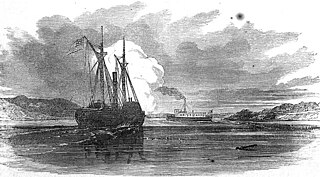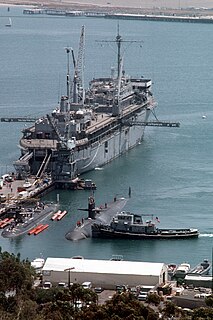
A tugboat or tug is a marine vessel that manoeuvres other vessels by pushing or pulling them, with direct contact or a tow line. These boats typically tug ships that cannot move well on their own, such as those in crowded harbours or narrow canals, or those that cannot move at all, such as barges, disabled ships, log rafts, or oil platforms. Some are ocean-going, some are icebreakers or salvage tugs. Early models had steam engines, and modern ones have diesel engines. Many have deluge guns, which help in firefighting, especially in harbours.

An auxiliary ship is a naval ship designed to support combatant ships and other naval operations. Auxiliary ships are not primary combatant vessels, though they may have some limited combat capacity, usually for purposes of self-defense.

USNS Apache (T-ATF-172), the fifth United States Navy ship of the name, is the last of the Powhatan class of fleet ocean tugs. Apache was delivered to the U.S. Navy in 1981. She is operated by Military Sealift Command and crewed by 18 civil service mariners (CIVMARS). She is designed to provide the Navy with towing service, and when augmented by Navy divers, assist in the recovery of downed aircraft and ships. There are quarters on board for up to 22 additional personnel.

The Ville-class harbour tugboats are a class of tugboats employed by the Royal Canadian Navy.

USS Nokomis (YT-142/YTB-142/YTM-142) was a Woban-class harbor tug built in Bremerton, Wash, and assigned to Pearl Harbor, Hawaii, in 1940. Nokomis was present during the Japanese attack on Pearl Harbor, 7 December 1941. She was the first vessel on scene at the USS Arizona, and was called off by the officers on deck because of the imminent explosion of the battery below deck. It then left and helped beach the USS Nevada, with Hoga (YT-146), and YT-153. The beaching of the Nevada saved Pearl Harbor's mouth from being blocked. After that the USS Nokomis fought fires and dewatered the battleship USS California, for 3 days. This effort made the California salvageable, to be recommissioned again later in the war. Nokomis was also the last vessel to move the surviving YC-699 barge prior to the Japanese attack on Pearl Harbor. Post-war she continued serving Pearl Harbor ships until she was decommissioned in May 1973, and eventually sold for "scrap" to Crowley, in San Francisco. She was renamed Sea Serpent and served many years in the San Francisco Bay as a tug and fire boat. In 1989, after the Loma Prieta earthquake in the SF Bay area, Nokomis and Hoga fought fires alongside each other again.

USS Wenonah (YT-148/YTB-148/YTM-148) was a Woban-class district harbor tug which served during World War II in California ports, and continued her service until she was struck by the Navy in 1974. On 17 August 2009, the Wenonah sank while berthed at Treasure Island, CA, and was raised by the floating crane Left Coast Lifter on 28 August 2009.

Washtucna (YTB-826) was a United States Navy Natick-class large harbor tug named for Chief Washtucna of the Palus tribe.
USS Evea (YT-458), originally the sixth USS Resolute (YT-458), later YTB-458, was a United States Navy tug in commission from 1943 to 1944.

Manhattan (YTB‑779/YT-800) is a United States Navy Natick-class large harbor tug named for Manhattan, New York.

The Baltic is a German emergency tow vessel (ETV) commissioned in 2010.

The Natick class is a class of harbor tugboats that have been active since the 1960s. Members of the class are named for Native American peoples and their members, USS Redwing excepted. As of 1 April 2015, five to eight Natick-class tugs remain in active service. Members of this class were designed under project SCB 147A.

Defiant (YT‑804) is a United States Navy Valiant-class harbor tug.

Valiant (YT‑802) is a United States Navy Valiant-class harbor tug.

Seminole (YT‑805) is a United States Navy Valiant-class harbor tug.

Puyallup (YT‑806) is a United States Navy Valiant-class harbor tug. The tugboat is named for the people of the Puyallup tribe.

Menominee (YT‑807) is a United States Navy Valiant-class harbor tug. The tugboat is named for the people of the Menominee tribe.

The Type V ship is a United States Maritime Commission (MARCOM) designation for World War II tugboats. Type V was used in World War II, Korean War and the Vietnam War. Type V ships were used to move ships and barges. Type V tugboats were made of either steel or wood hulls. There were four types of tugboats ordered for World War II. The largest type V design was the sea worthy 186-foot (57 m) long steel hull, V4-M-A1. The V4-M-A1 design was used by a number of manufacturers; a total of 49 were built. A smaller steel hull tugboat was the 94-foot (29 m) V2-ME-A1; 26 were built. The largest wooden hull was the 148-foot (45 m) V3-S-AH2, of which 14 were built. The smaller wooden hull was the 58-foot (18 m) V2-M-AL1, which 35 were built. Most V2-M-AL1 tugboats were sent to England for the war efforts under the lend-lease act. The Type V tugs served across the globe during World War II including: Pacific War, European theatre and in the United States. SS Farallon and other Type V tugs were used to help built Normandy ports, including Mulberry harbour, on D-Day, June 6, 1944 and made nine round trips to Normandy to deliver Phoenix breakwaters.
Everett-Pacific Shipbuilding & Dry Dock Company was established in 1942 to build ships needed for World War II. As part of the Emergency Shipbuilding Program the US Navy provided some of the capital to start Everett-Pacific Shipbuilding at Port Gardner Bay in Everett, Washington. Everett-Pacific was sold in 1945 to the Pacific Car and Foundry, who was already a major manufacturer of railcars and trucks. Pacific Car and Foundry was building barges for the US Navy during World War II at plants in Renton, Seattle and Tacoma in the state of Washington. The lease for the shipyard in Everett, Washington ended in 1949 and the yard closed. Pacific Car and Foundry in 1972 changed its name to Paccar Inc. to reflect its major products. The Everett-Pacific shipyard site later became part of Western Gear, a heavy machinery manufacturer. in 1987 the shipyard became part of Naval Station Everett. Everett-Pacific Shipbuilding was started by William Pigott Jr. a Seattle businessmen and his brother Paul Pigott (1900-1961). William Pigott Jr. was born in 26 Aug. 1895 in Pueblo, CO and died on 8 July 1947 in San Francisco, CA.

Bethlehem Shipbuilding San Pedro was a major shipbuilding company on Terminal Island in San Pedro, California owned by Bethlehem Shipbuilding Corporation. To support the World War 2 demand for ships Bethlehem Shipbuilding San Pedro built: US Navy Destroyers and after the war tugboats. At its peak during the war about 6,000 worked at the yard, Bethlehem Shipbuilding San Pedro shipyard was opened in 1918 as Southwestern Shipbuilding by Western Pipe & Steel. Western Pipe & Steel sold the shipyard to Bethlehem Shipbuilding Corporation in 1925. Shipbuilding ended after World War 2 in 1946. In 1983 the shipyard was sold to Southwest Marine. In 1997 Southwest Marine operated four shipyards, which they sold to The Carlyle Group. Carlyle Group renamed the shipyard US Marine Repair. In 2002 US Marine Repair sold all six of its yards to United Defense Industries. In 2005 it was sold to BAE Systems but the yard was not used and the yard is now part of the Port of Los Angeles. The shipyard was located at 1047 South Seaside Ave, San Pedro.

Anderson & Cristofani was a wooden shipbuilding company in San Francisco, California. To support the World War 2 demand for ships Anderson & Cristofani shipyard switched over to military construction and built: US Navy APC coastal transports, tugboatss, Patrol Boats and Minesweepers. Founded by Walter Anderson and Alfred Christofani. Anderson & Cristofani was started the early 1870s building San Francisco Bay scow schooners, which they built till the mid 1930s. Anderson & Cristofani built pleasure craft and workboats. The boatyard was on Innes Avenue, in the India Basin, at Hunter's Point. Henry P. Anderson, a shipwright from Denmark first worked at Dircks' boatyard when her arrived in 1893. Anderson joined Alf Cristofani in 1926 to form the Anderson & Cristofani Boatyard. The Anderson & Cristofani boatyard closed in 1988 and was taken over by Allemand Brothers boat repair, run by Rene Flip Allemand and John Allemand, started in 1946. Allemand Brothers boatyard closed in 2002. The land sold to property developers, but no project was built. The city of San Francisco purchased the land in 1989. In 2014 the city started the planning for the India Basin Shoreline Park at the site. The boatyard was at 900 Innes Ave, San Francisco.

















